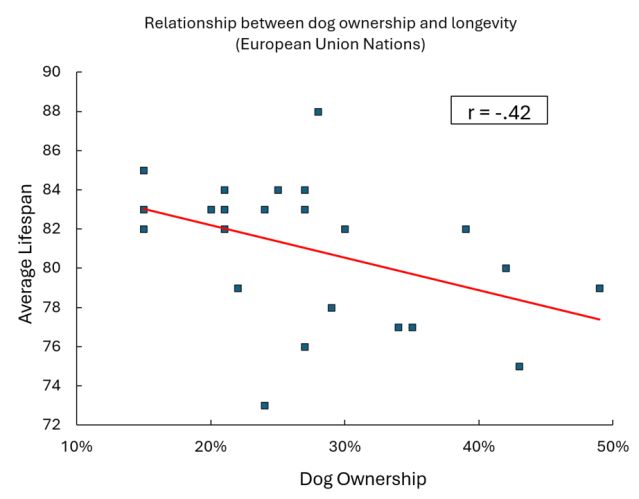Animal Behavior
Would Getting a Pet Help You Live Longer?
There's some good news for pet owners, and some bad.
Updated February 13, 2024 Reviewed by Lybi Ma
Key points
- The pet effect is the idea that pet ownership is linked to improved mental and physical health.
- A recent study of studies that concluded owners lived longer was widely covered in the media.
- Does the preponderance of evidence support the claim that pet owners are less likely to die?
- What accounts for national differences in the links between pet ownership and mortality?

The astronomer Carl Sagan famously cautioned, “Extraordinary claims require extraordinary evidence.” I recently came across an extraordinary claim by Beth Frates: "Pet owners are less likely to die.”
Frates is a lifestyle physician at Harvard’s T.H. Chan School of Public Health, and her surprising statement appeared in a Harvard Magazine article. Everyone, of course, dies. But is it possible that owning a pet adds years to your life?
Frates' claim was based on a reputable source—a peer-reviewed paper in the American Heart Association journal, Circulation: Cardiovascular Quality and Outcomes. In it, a research team headed by Caroline Kramer of the University of Toronto reported that dog ownership is associated with a whopping 24 percent decrease in mortality rates.
Too Good to Be True?
The idea that adopting a puppy will help you live longer is appealing—but did the results of the study meet Sagan’s extraordinary evidence bar? The research was a meta-analysis of studies on the association between dog ownership and death rates. Meta-analysis is a statistical technique in which investigators combine the results of multiple studies on the same topic—in this case, studies comparing the death rates of dog owners and non-owners.
The media jumped on these findings, err, like a dog on a bone. A CBS News headline read, “Dog Ownership Linked to 24 Percent Lower Risk of Dying Early." However, the authors of the study made a serious mistake in their analysis—they did not take into account that pet owners are different from non-owners in many ways.
For example, in a study of 22,000 pet owners and 19,000 non-owners by the Rand Corporation pet owners tended to be younger, wealthier, and more educated than non-pet owners. Pet owners were also more likely to be White, married, have children, own their own home, and have better general health. Once the researchers plugged these variables into their analysis, the presumed benefits of pet ownership on physical health vanished. (See Large Study Finds Pet Owners Are Different.)
Other researchers quickly pointed out methodical errors in the meta-analysis published by the American Heart Association. A team headed by Adrian Bauman of Sydney University reanalyzed the results of the studies used in the original paper. Their improved meta-analysis subsequently appeared in the journal. When demographic and socioeconomic differences between dog owners and non-owners were included in their analysis, Brauman’s group found there was not a significant association between pet ownership and mortality rates.
I was intrigued by these conflicting findings and took a deep dive into the studies on pet ownership and death rates. I searched for population-based epidemiological studies in which owners and non-owners were followed over time. I found nine studies published in peer-reviewed publications between 2010 and 2023. In comparing the death rates of pet owners and non-owners, all of them statistically controlled for confounding variables such as sex, age, and chronic medical conditions. And, ranging from 4,000 to 3.5 million participants, they were very large. (The median number of subjects in the studies was 59,342 individuals.)
The Truth About Pets and Death
Here are the results of the studies in chronological order.
- The 2010 American Study – Richard Gillum and Thomas Obisesan examined the survival rates of a national cohort of 11,433 American adults in the National Health Examination Survey. Over an average of eight years, neither cat nor dog owners were less likely to have died than non-owners.
- The 2017 Australian Study – Using data from over 4,000 participants in the Australian National Blood Pressure Study, Enayat Chowdhury and his colleagues assessed whether pet owners between the ages of 65 and 67 lived longer than non-owners. Over 11 years, there were 958 “fatal events” among the participants. While pet owners were less likely to have died of coronary disease than non-owners, as a group, people with pets did not live longer than the non-owners.
- The 2017 Norwegian Study – Researchers from the Norwegian University of Science and Technology examined death rates among over, 53,000 residents of Nord-Trøndelag County, Norway. Over 20 years, 24 percent of the participants died. In their paper, the researchers wrote, “We found no evidence for an association between the presence of a dog in the household and all-cause mortality.”
- The 2017 Swedish Study – The strongest findings linking pet ownership with longevity came from a pair of studies by a highly regarded research group led by Tove Fall at Uppsala University. Their first study involved nearly 3.5 million Swedish dog owners and non-owners. Over 12 years, 24,000 participants died. The good news is that after adjusting for variables such as sex, income, marital status, presence of children in the home, and income, dog owners had a 20 percent lower mortality rate than non-owners.
- Now the bad news. The research team obtained different results when they separately examined the death rates of the 34,000 subjects who were also in the Swedish Twin Registry. This is a long-term research project that includes additional information related to health and lifestyle factors. When the team accounted for confounding variables including body mass index, smoking, chronic medical conditions, employment status, and level of exercise, there was no effect of dogs on mortality rates.
- The 2018 English Study – University of Sydney researchers examined the impact of living with a dog on survival among nearly 60,000 English adults participating in the Health Survey of England. Over an average of 11 years, 8,169 individuals had died. The researchers concluded, “There is no evidence for an association between living in a household with a dog and all-cause or cardiovascular disease mortality in this large sample.”
- The 2018 Danish Study – Ivalu Sørensen and her colleagues examined dog ownership among all 46,000 Danes over the age of 18 who died in 2015. The researchers matched each of the deceased on a slew of variables with people who did not die during the same period. Their results were mixed. There was no “dog effect" on death rates of people who were married, but dog owners without a spouse had 14 percent lower mortality.
- The 2019 Swedish Study – The second study on dogs and mortality by Uppsala University was published in 2019 in the journal Circulation (alongside the flawed meta-analysis). This time, the researchers obtained the mortality rates among 180,000 individuals in Sweden who had been hospitalized after having a heart attack or stroke between 2001 and 2012. They found that dog ownership was linked to lower mortality rates in both cardiac and stroke patients. Further, the positive dog ownership effect on survival was particularly pronounced among people living alone in both the heart attack and stroke groups.
- The 2022 European Study – Researchers from the University of Athens reported the result of an epidemiological study of over 23,000 individuals from 21 countries who were part of the Survey of Health and Aging and Retirement in Europe. During a 10-year follow-up, 5,163 of the participants died. The researchers found there were no differences in the survival rates of pet owners and non-owners. (The only exception was that older women who had a pet bird were more likely to die.)
- The 2023 (Linköping University) Sweden Study – Swedish researchers compared the mortality rates of 8,352 dog owners and 209,993 non-owners in the Swedish National Diabetes Register. Over 16 years, 18,943 individuals died—most of them from heart attacks. After adjusting for differences in age and sex, the investigators found there were no differences in the risks of death between people with and without dogs.
Most Studies Have Not Found Pet Owners Live Longer
An editorial by Harvard Medical School's Dhruv Kazi accompanied the flawed 2019 meta-analysis. He wrote that, because the link between dog ownership and mortality has been found across many countries and populations, "it is safe to assume that the association is real."
However, the only population-based research that reported differences in death rates between pet owners and nonowners was from Scandinavia, the two studies from Tove Falls' group in Sweden and the study in Denmark that found lower mortality in dog owners without a spouse. Indeed, among European Union nations, countries in which people live longer, tend to have lower—not higher—rates of dog ownership. (For stat nerds, r = -.42).

In an email, Fall suggested a possible explanation for these results: "Scandinavian dog owners might be a bit more dedicated as animal welfare laws are strict here. If you are among the few selected who get a dog, you walk the dog and maybe are more likely to have the health to do it. There are many publically accessible green areas here. Another aspect is that our results are mainly driven by the association in single households. On a global scale, Sweden has a high proportion of single-households—the most common form of household in the country according to Eurostat. On a European scale, Sweden is number one on this list and Denmark number three."
Does research support the contention that pet owners are less likely to die? If we take Carl Sagan’s warning that “extraordinary claims require extraordinary evidence," unfortunately the answer seems to be no, unless you live in Scandinavia.
Facebook image: SB Arts Media/Shutterstock
References
Chowdhury, E. K., Nelson, M. R., Jennings, G. L. R., Wing, L. M. H., Reid, C. M., & Committee, on behalf of the A. M. (2017). Pet ownership and survival in the elderly hypertensive population. Journal of Hypertension, 35(4), 769.
Christopoulos, K., Benetou, V., Riza, E., & Pantazis, N. (2022). Pet ownership and survival of European older adults. European Journal of Ageing, 19(4), 1549–1560.
Ding, D., Bauman, A. E., Sherrington, C., McGreevy, P. D., Edwards, K. M., & Stamatakis, E. (2018). Dog Ownership and Mortality in England: A Pooled Analysis of Six Population-based Cohorts. American Journal of Preventive Medicine, 54(2), 289–293.
Gillum, R. F., & Obisesan, T. O. (2010). Living with Companion Animals, Physical Activity and Mortality in a U.S. National Cohort. International Journal of Environmental Research and Public Health, 7(6), Article 6.
Mubanga, M., Byberg, L., Nowak, C., Egenvall, A., Magnusson, P. K., Ingelsson, E., & Fall, T. (2017). Dog ownership and the risk of cardiovascular disease and death – a nationwide cohort study. Scientific Reports, 7(1), 15821.
Mubanga, M., Byberg, L., Egenvall, A., Ingelsson, E., & Fall, T. (2019). Dog Ownership and Survival After a Major Cardiovascular Event. Circulation: Cardiovascular Quality and Outcomes, 12(10), e005342.
Rådholm, K., af Geijerstam, P., Woodward, M., Chalmers, J., Hellgren, M., Jansson, S., & Rolandsson, O. (2023). Dog ownership, glycaemic control and all-cause death in patients with newly diagnosed type 2 diabetes: A national cohort study. Frontiers in Public Health, 11, 1265645.
Sørensen, I. K., Bidstrup, P. E., Rod, N. H., Rühling, T., & Johansen, C. (2018). Is dog ownership associated with mortality? A nationwide registry study. European Journal of Public Health, 28(6), 1169–1171.
Torske, M. O., Krokstad, S., Stamatakis, E., & Bauman, A. (2017). Dog ownership and all-cause mortality in a population cohort in Norway: The HUNT study. PLOS ONE, 12(6), e0179832.




